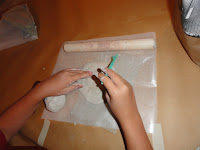The third graders made big mouthed fantasy fish for their ceramics project. This is, of course, the project that they look forward to all year long....
I started off the project by reading them the book,
Fidgety Fish by Ruth Galloway. We ended up having quite a lively discussion about what the word fidgety means and in what instances they become fidgety! It ended up being a very good teachable moment!
From there, the students got out their sketchbooks and they had the rest of class to draw 2 imaginary fish.
The criteria for this project:
1) had to be an imaginary sea creature (but could combine aspects of real ones)
2) had to have 2 textures
3) had to have 2 patterns
When they came in for the next class, I had a tray of clay slabs ready to go (I bought a heavy duty slicer- it looks like a large cheese slicer. I use this to cut all of my clay slabs. I can get them done in just a few minutes and they are all a uniform size. I rarely use my slab roller- it is too awkward for my students to use and I am always worried about their fingers getting caught).
I give each child a slab of clay and show them how to roll it like a taco (lots of giggles at this analogy). They have to smooth the edges together or it will crack when the clay dries.
Then they have to decide which end they want to be the big mouth and which end they want to be the tail.
The tail end gets close up and pinched together. They can then use their clay tools to cut out the shape they want their tail to be.
The mouth gets left open. Most of the students left it as an oval or a circle. I had a few adventurous students who tried making square and heart shaped
mouths.
Then I gave each student a ball of clay. They used this to add fins, eyes, teeth, tongues, etc. I showed them how to score their pieces before attaching them (we lost a few eyes and teeth that were not attached well).
They used their tools (clay knives, Popsicle sticks, toothpicks, pencils, straws, etc) to add texture to their fish and then brought them to me as they finished up. I added their initials and class code to the bottom and then left them on their class shelf to dry.
After they had been fired, the students were ready to glaze.
I placed 6-8 different colors on each table and we talked about how they needed to cover the entire area that could be seen (they were NOT to glaze the bottom). They were also told to glaze the inside of the mouth. I reminded them 1 last time that I needed to see some sort of pattern on their fish and then they were off!
I fired them 1 last time and these are a few of the finished products.
Pin It
 Our youngest group then worked on leaf rubbings. I had the leaf pattern rubbing plates that I had bought from Sax (order number 076928). The children did a various rubbings on manila paper and then cut them out. They glued these onto another piece of paper, building animals, people, faces, etc.
Our youngest group then worked on leaf rubbings. I had the leaf pattern rubbing plates that I had bought from Sax (order number 076928). The children did a various rubbings on manila paper and then cut them out. They glued these onto another piece of paper, building animals, people, faces, etc.
 The next group used their collected materials to build their own Leaf Man... or butterfly, or flower, or... anything they could imagine. They glued the piece onto paper and added a other scrap materials that we had left over from previous classes.
The next group used their collected materials to build their own Leaf Man... or butterfly, or flower, or... anything they could imagine. They glued the piece onto paper and added a other scrap materials that we had left over from previous classes.  The last group built a leaf man face out of air dry clay. I had them place the clay onto a piece of wax paper. They rolled the clay out and built the face first. They used pieces of clay to create their own leaves, berries, grass, etc. Those that had brought their own natural elements used these to add fun details to their faces.
The last group built a leaf man face out of air dry clay. I had them place the clay onto a piece of wax paper. They rolled the clay out and built the face first. They used pieces of clay to create their own leaves, berries, grass, etc. Those that had brought their own natural elements used these to add fun details to their faces.









































